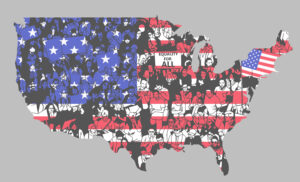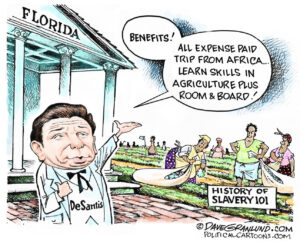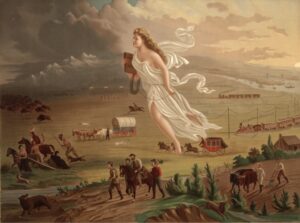|
To see long excerpts from “The Internal Enemy” at Google Books, click here.
|
“The Internal Enemy: Slavery and War in Virginia, 1772-1832”
A book by Alan Taylor
You may not remember all the words to “The Star-Spangled Banner,” but did you know that Francis Scott Key wrote several verses? Or that the third verse takes a swipe at the British for emancipating American slaves during the War of 1812?
No refuge could save the hireling and slave
From the terror of flight, or the gloom of the grave
And the star-spangled banner in triumph doth wave
O’er the land of the free and the home of the brave.
Key wrote the poem to celebrate the failure of the British navy to capture Baltimore in 1814, giving a much-needed boost to American morale after Britain’s recent humiliating destruction of Washington, D.C. But what Alan Taylor wants us to notice here, and throughout his remarkable new book, is the way white Americans so readily equated their own freedom with the enslavement of blacks. The miserable hirelings and slaves employed by the British would go to their well-deserved graves, reads our national anthem, so that America would remain “the land of the free.”
By the time Key wrote those words, the British had already terrified the whites in the area around Chesapeake Bay by invading their farms and plantations, sacking their towns and villages, and freeing their slaves. Thousands of slaves. Some enlisted in the British navy, others were “carried off” to freedom in Bermuda, Nova Scotia and Trinidad. It’s an extraordinary story, and “The Internal Enemy” tells it in vivid prose and compelling, deeply researched detail. But Taylor never gets lost in those details. He has important things to say — about slavery, about war and about America.
The slaves of Virginia were the internal enemy of Taylor’s title and he opens their story with the War of Independence. In November 1775, months before Jefferson drafted his famed declaration, British officers in Virginia had begun promising freedom to slaves who escaped from their rebellious owners to enlist with His Majesty’s forces. Because black Virginians knew the surrounding countryside much better than the invaders, escaping slaves became a crucial resource for the British war effort. Soon the British were emancipating entire slave families who took advantage of the American Revolution to claim their freedom in Canada or the Caribbean. Taylor tells this familiar story well and uses it to introduce readers to his two major themes.
The first is the great paradox of slavery and freedom. Taylor is not interested in denouncing the Founders as hypocrites. Rather, “The Internal Enemy,” which has been shortlisted for the 2013 National Book Award, is best read as a sequel to Edmund Morgan’s classic 1975 study, “American Slavery, American Freedom: The Ordeal of Colonial Virginia.” Morgan argued that Virginians relieved the dangerous class conflict between rich and poor by replacing white servants with black slaves. Freedom and opportunity for whites came to depend on the enslavement of blacks, leaving us with the perplexing spectacle of wealthy Virginia planters mounting a revolution in the name of universal liberty. Taylor picks up where Morgan left off. (And like Morgan, Taylor wears his sophistication lightly.) He shows how some of the most libertarian consequences of the Revolution actually deepened Virginia’s attachment to slavery. For example, Virginia leaders abolished the aristocratic practice of bequeathing estates to the eldest son and entailing plantations so that they could never be sold out of the family line. The result, Taylor shows, was not only the accelerated decline of the old First Families of Virginia and the breakup of their estates, but also the dispersal of slave ownership much more broadly among ordinary whites. Freedom and economic opportunity in Virginia came to depend more than ever on the continued enslavement of blacks.
The Revolution taught white Virginians something else. Their slaves could not be trusted, precisely because they took seriously Jefferson’s appeal to human equality and universal freedom. This is Taylor’s second theme. The slaves, resenting their bondage more than ever, became the internal enemy of their masters’ nightmares. Jolted by the escape of thousands of their slaves to the hated British, many whites began to wonder if they weren’t sitting atop a powder keg that could explode at any moment into slave rebellion. Prominent planters dreamed up schemes of gradual emancipation to be followed by the colonization of blacks somewhere beyond the borders of the United States. They sincerely wanted all men to be free, but they just as sincerely wanted all Americans to be white.
The contradictions of early Virginia society became glaringly obvious during the War of 1812. Once again the British invaded the tidewater areas of Virginia. Once again they enticed slaves with offers of freedom. And once again thousands of slaves took advantage of the offer. At its heart “The Internal Enemy” is the story of slavery in Virginia during the War of 1812 — not only of slaves, but of slaveholders. One chapter is devoted to a case study of Corotoman, a large Virginia planation that passed by marriage from one of the wealthiest families in colonial Virginia — the Carters — into the hands of St. George Tucker, one of the most respected planter-lawyers of the post-revolutionary generation. The Tucker family saga was played out against a backdrop of general economic decline for Virginia planters, and the endless struggle between white owners and managers on the one hand and the restless internal enemy on the other. Taylor traces the shattering effect of the British invasion during the War of 1812 on plantations like Corotoman.But the same invasion that disrupted so many Tidewater plantations offered the chance of freedom to thousands of Virginia slaves. Taylor shows that wartime runaways often escaped in family groups, unlike the individual young men who most often absconded in peacetime. He takes us to Nova Scotia and Trinidad to show us the kind of lives the former Virginia slaves were able to build for themselves. They were poor, they were often discriminated against, but they were free, they knew it, and they said so in poignant but unflinching letters to their former owners. By unearthing and quoting from these extraordinary documents, Taylor demolishes the myth that the British cynically re-enslaved the very people they had enticed with offers of freedom.
Taylor writes locally, but thinks globally. He does not doubt, for example, that the British were sincerely committed to freeing Virginia slaves, but he also knows that British imperialists were learning from their experience how to use emancipation as a moral justification for their own projects of colonial expansion. Indeed, it’s hard not to be dazzled by the ease with which Taylor moves from the lives of individual slaves, to the history of a large planter family, to the fault lines of Virginia politics, to the national debate over slavery in the western territories, out into the Atlantic world, to the history of the British Empire.
Taylor is not the first historian to suggest that the War of 1812 was a turning point in American history, but the direction he sees America turning is not the familiar one. The war did not awaken a unifying American nationalism or usher in an “era of good feelings.” On the contrary, Taylor argues, it left an embittered legacy of sectional animosity. New Englanders had never much liked the war and were in no hurry to help Virginians keep their black workers enslaved. Southerners came away from the experience deeply suspicious of their northern countrymen. This sectional conflict would explode into national politics with the Missouri crisis a few years later. But the tension would not be resolved until another war, an immense and brutal Civil War, finally broke the powerful and disfiguring link between slavery and freedom in the United States.
James Oakes is the author of “Freedom National: The Destruction of Slavery in the United States, 1861-1865.”
©2013, Washington Post Book World Service/Washington Post Writers Group










You need to be a supporter to comment.
There are currently no responses to this article.
Be the first to respond.